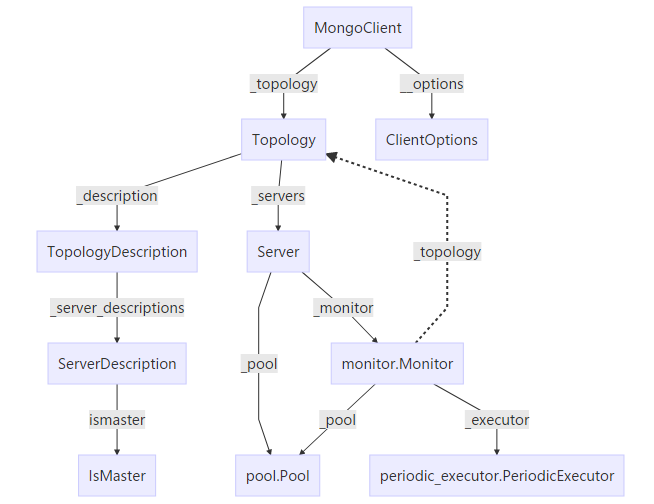在CAP理论与MongoDB一致性、可用性的一些思考一文中提到,MongoDB提供了一些选项,如Read Preference、Read Concern、Write Concern,对MongoDB的一致性、可用性、可靠性(durability)、性能会有较大的影响。与Read Concern、Write Concern不同的是,Read Preference基本上完全由MongoDb Driver实现,因此,本文通过PyMongo来看看Read Preference具体是如何实现的。
本文分析的PyMongo版本是PyMongo3.6,该版本兼容MongoDB3.6及以下的MongoDB。
本文地址:https://www.cnblogs.com/xybaby/p/10256812.html
Read Preference
Read preference describes how MongoDB clients route read operations to the members of a replica set.
Read Prefenrece决定了使用复制集(replica set)时,读操作路由到哪个mongod节点,如果使用Sharded Cluster,路由选择由Mongos决定,如果直接使用replica set,那么路由选择由driver决定。如下图所示:
MongoDB提供了以下Read Preference Mode:
- primary:默认模式,一切读操作都路由到replica set的primary节点
- primaryPreferred:正常情况下都是路由到primary节点,只有当primary节点不可用(failover)的时候,才路由到secondary节点。
- secondary:一切读操作都路由到replica set的secondary节点
- secondaryPreferred:正常情况下都是路由到secondary节点,只有当secondary节点不可用的时候,才路由到primary节点。
- nearest:从延时最小的节点读取数据,不管是primary还是secondary。对于分布式应用且MongoDB是多数据中心部署,nearest能保证最好的data locality。
这五种模式还受到maxStalenessSeconds和tagsets的影响。
不同的read Preference mode适合不同的应用场景,如果数据的一致性很重要,比如必须保证read-after-write一致性,那么就需要从primary读,因为secondary的数据有一定的滞后。如果能接受一定程度的stale data,那么从secondary读数据可以减轻primary的压力,且在primary failover期间也能提供服务,可用性更高。如果对延时敏感,那么适合nearest。另外,通过tagsets,还可以有更丰富的定制化读取策略,比如指定从某些datacenter读取。
PyMongo
首先给出pymongo中与read preference相关的类,方便后面的分析。

上图中实线箭头表示强引用(复合),虚线箭头表示弱引用(聚合)
connect to replica set
PyMongo的文档给出了如何连接到复制集:指定复制集的名字,以及一个或多个该复制集内的节点。如:
MongoClient('localhost', replicaset='foo')
上述操作是non-blocking,立即返回,通过后台线程去连接指定节点,PyMongo连接到节点后,会从mongod节点获取到复制集内其他节点的信息,然后再连接到复制集内的其他节点。
from time import sleep
c = MongoClient('localhost', replicaset='foo'); print(c.nodes); sleep(0.1); print(c.nodes)
frozenset([])
frozenset([(u'localhost', 27019), (u'localhost', 27017), (u'localhost', 27018)])
可以看到,刚初始化MongoClient实例时,并没有连接到任何节点(c.nodes)为空;过了一段时间,再查看,那么会发现已经连上了复制集内的三个节点。
那么问题来了,创建MongoClient后,尚未连接到复制集节点之前,能否立即操作数据库?
If you need to do any operation with a MongoClient, such as a find() or an insert_one(), the client waits to discover a suitable member before it attempts the operation.
通过后续的代码分析可以看到,会通过一个条件变量(threading.Condition)去协调。
PyMongo Monitor
上面提到,初始化MongoClient对象的时候,会通过指定的mognod节点去发现复制集内的其他节点,这个就是通过monitor.Monitor来实现的。从上面的类图可以看到,每一个server(与一个mongod节点对应)都有一个monitor。Monitor的作用在于:
- Health: detect when a member goes down or comes up, or if a different member becomes primary
- Configuration: detect when members are added or removed, and detect changes in members’ tags
- Latency: track a moving average of each member’s ping time
Monitor会启动一个后台线程 PeriodExecutor,定时(默认10s)通过socket连接Pool给对应的mongod节点发送 ismaster 消息。核心代码(略作调整)如下
def _run(self):
self._server_description = self._check_with_retry()
self._topology.on_change(self._server_description)
def _check_with_retry(self):
address = self._server_description.address
response, round_trip_time = self._check_with_socket(
sock_info, metadata=metadata)
self._avg_round_trip_time.add_sample(round_trip_time) # 更新rtt
sd = ServerDescription(
address=address,
ismaster=response,
round_trip_time=self._avg_round_trip_time.get())
return sd
def _check_with_socket(self, sock_info, metadata=None):
"""Return (IsMaster, round_trip_time).
Can raise ConnectionFailure or OperationFailure.
"""
cmd = SON([('ismaster', 1)])
if metadata is not None:
cmd['client'] = metadata
if self._server_description.max_wire_version >= 6:
cluster_time = self._topology.max_cluster_time()
if cluster_time is not None:
cmd['$clusterTime'] = cluster_time
start = _time()
request_id, msg, max_doc_size = message.query(
0, 'admin.$cmd', 0, -1, cmd,
None, DEFAULT_CODEC_OPTIONS)
# TODO: use sock_info.command()
sock_info.send_message(msg, max_doc_size)
reply = sock_info.receive_message(request_id)
return IsMaster(reply.command_response()), _time() - start
类IsMaster是对ismaster command reponse的封装,比较核心的属性包括:
- replica_set_name:从mongod节点看来,复制集的名字
- primary:从mongod节点看来,谁是Priamry
- all_hosts: 从mongod节点看来,复制集中的所有节点
- last_write_date: mongod节点最后写入数据的时间,用来判断secondary节点的staleness
- set_version:config version
- election_id:只有当mongod是primary时才会设置,表示最新的primary选举编号
当某个server的monitor获取到了在server对应的mongod上的复制集信息信息时,调用Tolopogy.on_change更新复制集的拓扑信息:
def on_change(self, server_description):
"""Process a new ServerDescription after an ismaster call completes."""
if self._description.has_server(server_description.address):
self._description = updated_topology_description(
self._description, server_description)
self._update_servers() # 根据信息,连接到新增的节点,移除(断开)已经不存在的节点
self._receive_cluster_time_no_lock(
server_description.cluster_time)
# Wake waiters in select_servers().
self._condition.notify_all()
核心在updated_topology_description, 根据本地记录的topology信息,以及收到的server_description(来自IsMaster- ismaster command response),来调整本地的topology信息。以一种情况为例:收到一个ismaster command response,对方自称自己是primary,不管当前topology有没有primary,都会进入调用以下函数
def _update_rs_from_primary(
sds,
replica_set_name,
server_description,
max_set_version,
max_election_id):
"""Update topology description from a primary's ismaster response.
Pass in a dict of ServerDescriptions, current replica set name, the
ServerDescription we are processing, and the TopologyDescription's
max_set_version and max_election_id if any.
Returns (new topology type, new replica_set_name, new max_set_version,
new max_election_id).
"""
if replica_set_name is None:
replica_set_name = server_description.replica_set_name
elif replica_set_name != server_description.replica_set_name: # 不是来自同一个复制集
# We found a primary but it doesn't have the replica_set_name
# provided by the user.
sds.pop(server_description.address)
return (_check_has_primary(sds),
replica_set_name,
max_set_version,
max_election_id)
max_election_tuple = max_set_version, max_election_id
if None not in server_description.election_tuple:
if (None not in max_election_tuple and
max_election_tuple > server_description.election_tuple): # 节点是priamry,但比topology中记录的旧
# Stale primary, set to type Unknown.
address = server_description.address
sds[address] = ServerDescription(address) # 传入空dict,则server-type为UnKnown
return (_check_has_primary(sds),
replica_set_name,
max_set_version,
max_election_id)
max_election_id = server_description.election_id
if (server_description.set_version is not None and # 节点的config version版本更高
(max_set_version is None or
server_description.set_version > max_set_version)):
max_set_version = server_description.set_version
# We've heard from the primary. Is it the same primary as before?
for server in sds.values():
if (server.server_type is SERVER_TYPE.RSPrimary
and server.address != server_description.address):
# Reset old primary's type to Unknown.
sds[server.address] = ServerDescription(server.address)
# There can be only one prior primary.
break
# Discover new hosts from this primary's response.
for new_address in server_description.all_hosts:
if new_address not in sds:
sds[new_address] = ServerDescription(new_address)
# Remove hosts not in the response.
for addr in set(sds) - server_description.all_hosts:
sds.pop(addr)
# If the host list differs from the seed list, we may not have a primary
# after all.
return (_check_has_primary(sds),
replica_set_name,
max_set_version,
max_election_id)
注意看docstring中的Returns,都是返回新的复制集信息
那么整个函数从上往下检查
- 是不是同一个复制集
- 新节点(自认为是primary)与topology记录的primary相比,谁更新。比较(set_version, election_id)
- 比较set_servion
- 如果topology中已经有stale primary,那么将其server-type改成Unknown
- 从Primary节点的all_hosts中取出新加入复制集的节点
- 移除已经不存在于复制集中的节点
PyMongo关于复制集的状态都来自于所有节点的ismaster消息,Source of Truth在于复制集,而且这个Truth来自于majority 节点。因此,某个节点返回给driver的信息可能是过期的、错误的,driver通过有限的信息判断复制集的状态,如果判断失误,比如将写操作发到了stale primary上,那么会在复制集上再次判断,保证正确性。
PyMongo read preference
前面详细介绍了PyMongo是如何更新复制集的信息,那么这一部分来看看基于拓扑信息具体是如何根据read preference路由到某个节点上的。
我们从Collection.find出发,一路跟踪, 会调用MongoClient._send_message_with_response
def _send_message_with_response(self, operation, read_preference=None,
exhaust=False, address=None):
topology = self._get_topology()
if address:
server = topology.select_server_by_address(address)
if not server:
raise AutoReconnect('server %s:%d no longer available'
% address)
else:
selector = read_preference or writable_server_selector
server = topology.select_server(selector)
return self._reset_on_error(
server,
server.send_message_with_response,
operation,
set_slave_ok,
self.__all_credentials,
self._event_listeners,
exhaust)
代码很清晰,根据指定的address或者read_preference, 选择出server,然后通过server发请求,等待回复。topology.select_server一路调用到下面这个函数
def _select_servers_loop(self, selector, timeout, address):
"""select_servers() guts. Hold the lock when calling this."""
now = _time()
end_time = now + timeout
server_descriptions = self._description.apply_selector( # _description是TopologyDescription
selector, address)
while not server_descriptions:
# No suitable servers.
if timeout == 0 or now > end_time:
raise ServerSelectionTimeoutError(
self._error_message(selector))
self._ensure_opened()
self._request_check_all()
# Release the lock and wait for the topology description to
# change, or for a timeout. We won't miss any changes that
# came after our most recent apply_selector call, since we've
# held the lock until now.
self._condition.wait(common.MIN_HEARTBEAT_INTERVAL) # Conditional.wait
self._description.check_compatible()
now = _time()
server_descriptions = self._description.apply_selector(
selector, address)
self._description.check_compatible()
return server_descriptions
可以看到,不一定能一次选出来,如果选不出server,意味着此时还没有连接到足够多的mongod节点,那么等待一段时间(_condition.wait)重试。在上面Topology.on_change 可以看到,会调用_condition.notify_all唤醒。
def apply_selector(self, selector, address):
def apply_local_threshold(selection):
if not selection:
return []
settings = self._topology_settings
# Round trip time in seconds.
fastest = min(
s.round_trip_time for s in selection.server_descriptions)
threshold = settings.local_threshold_ms / 1000.0
return [s for s in selection.server_descriptions
if (s.round_trip_time - fastest) <= threshold]
# 省略了无关代码...
return apply_local_threshold(
selector(Selection.from_topology_description(self)))
上面selector就是read_preference._ServerMode的某一个子类,以Nearest为例
class Nearest(_ServerMode):
def __call__(self, selection):
"""Apply this read preference to Selection."""
return member_with_tags_server_selector(
self.tag_sets,
max_staleness_selectors.select(
self.max_staleness, selection))
首先要受到maxStalenessSeconds的约束,然后再用tagsets过滤一遍,这里只关注前者。
关于maxStalenessSeconds
The read preference maxStalenessSeconds option lets you specify a maximum replication lag, or “staleness”, for reads from secondaries. When a secondary’s estimated staleness exceeds maxStalenessSeconds, the client stops using it for read operations.
怎么计算的,如果节点有primary,则调用下面这个函数
def _with_primary(max_staleness, selection):
"""Apply max_staleness, in seconds, to a Selection with a known primary."""
primary = selection.primary
sds = []
for s in selection.server_descriptions:
if s.server_type == SERVER_TYPE.RSSecondary:
# See max-staleness.rst for explanation of this formula.
staleness = (
(s.last_update_time - s.last_write_date) -
(primary.last_update_time - primary.last_write_date) +
selection.heartbeat_frequency)
if staleness <= max_staleness:
sds.append(s)
else:
sds.append(s)
return selection.with_server_descriptions(sds)
上面的代码用到了IsMaster的last_write_date属性,正是用这个属性来判断staleness。
公式的解释可参考max-staleness.rst
个人觉得可以这么理解:假设网络延时一致,如果在同一时刻收到心跳回复,那么只用P.lastWriteDate - S.lastWriteDate就行了,但心跳时间不同,所以得算上时间差。我会写成(P.lastWriteDate - S.lastWriteDate) + (S.lastUpdateTime - P.lastUpdateTime) 。加上 心跳间隔是基于悲观假设,如果刚心跳完之后secondary就停止复制,那么在下一次心跳之前最多的stale程度就得加上 心跳间隔。
从代码可以看到Nearest找出了所有可读的节点,然后通过apply_local_threshold函数来刷选出最近的。